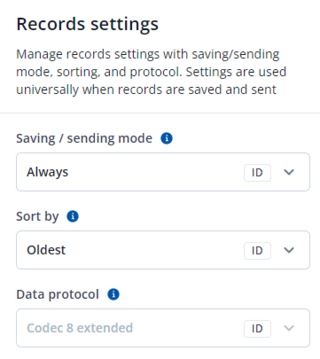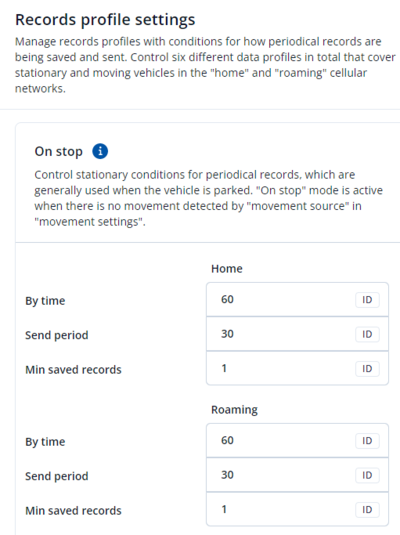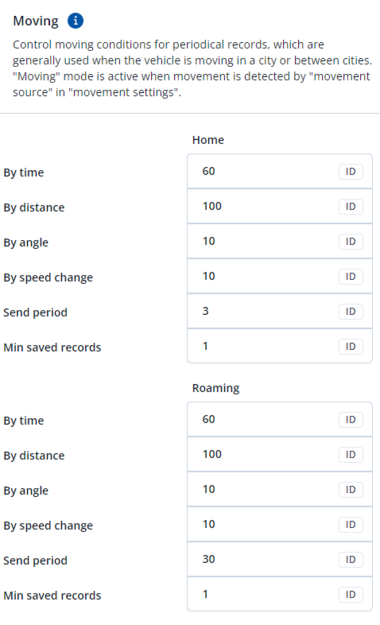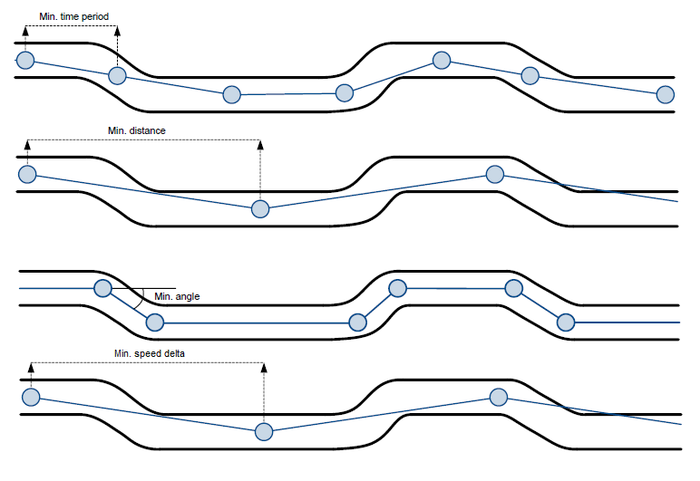Difference between revisions of "FTC921 Tracking settings"
(Created page with "==Records settings== right|320 px '''Saving / sending mode''' This feature will be used to save and send records to server without time...") |
|||
| Line 53: | Line 53: | ||
[[Image:Fmb120_daq_mode_basis.png|700px|none]] | [[Image:Fmb120_daq_mode_basis.png|700px|none]] | ||
| + | |||
| + | [[Category:FTC921 Configuration]] | ||
Revision as of 14:50, 29 May 2023
Main Page > Basic Trackers > FTC921 > FTC921 Configuration > FTC921 Tracking settingsRecords settings
Saving / sending mode
This feature will be used to save and send records to server without time sinchronization.
Possible options:
After Position Fix - records will be saved and send only after position fix
After Time Sync - records will be saved and send only after time synchronization
Always - records will be always saved and send even if will not be time synchronization
Note: If record is without valid coordinates – (there were no GPS fix in the moment of data acquisition) – Longitude, Latitude and Altitude values are last valid fix, and Angle, Satellites and Speed are 0. After a reboot, it will send zero coordinates.
Sort by
Can be set either Newest or Oldest. For example if the Oldest is marked the device first will send the Oldest information, if Newest then Device will send the newest information. If the device had no connection (GSM or GPRS) due to bad coverage or being in an area with no signal. Device continues to save records into internal memory, once GSM and GPRS are recovered device will start sending saved data to server. In this example, if Oldest is configured - until newest data is seen on the server all of the oldest records have to be sent first. If Newest is configured - previous data and track won't be seen until newest data is sent first. If high priority on I/O parameters or Features are configured device will send the generated records with High Priority first.
Data protocol
In Data Protocol settings user can choose which protocol version (Codec 8 or Codec 8 Extended) will use for data sending to the server.
Records profile settings
Data Acquisition modes are an essential part of FTC921 device, they are also highly configurable.
Through configuration user defines how records will be saved and sent. There are two different modes: Home and Roaming. All these modes with configured data acquisition and report frequencies depend on the current GSM Operator and are switched when GSM operator changes (e.g. vehicle passes through a country border).
If current GSM operator is defined as Home Operator, the device will work in Home Data Acquisition mode, if the current operator is defined as Roaming Operator, the device will work in Roaming Data Acquisition mode.
This functionality allows having different AVL records to acquire and send parameter values when the object is moving or standing still. Vehicle moving or stop state is defined by the Stop Detection Source parameter. There are 3 ways for FTC921 to switch between Vehicle on Stop and Vehicle Moving modes, please refer to Movement settings in FTC921 System.
The operator search is performed every 15 minutes. Depending on the current GSM operator Home or Roaming mode can be changed faster than every 15 minutes. This process is separate from the operator search. Movement criteria are checked every second.
Record Saving settings
Min Saved Records defines the minimum number of coordinates and I/O data that should be transferred within a single connection to the server. If FTC921 does not have enough coordinates to send to the server, it will check again after a time interval defined in Send Period field.
Send period controls the frequency of data being sent to the server over GPRS. The module makes attempts to send collected data to the server every defined period of time. If it does not have enough records (depends on the parameter Min. Saved Records described above), it tries again after the defined time interval.
| Keep in mind that FTC921 operates in GMT:0 time zone, without daylight saving. |
FTC921 is able to collect records using four methods at the same time: time, distance, angle, and speed-based data acquisition:
- Time based data acquisition (Min Period) – records are acquired every time when a defined interval of time passes. Entering zero disables data acquisition based on time.
- Distance-based data acquisition (Min Distance) – records are acquired when the distance between the previous coordinate and current position is greater than a defined parameter value. Entering zero disables data acquisition based on distance.
- Angle based data acquisition (Min Angle) – records are acquired when the angle difference between the last recorded coordinate and current position is greater than a defined value. Entering zero disables data acquisition based on the angle.
- Speed based data acquisition (Min Speed Delta) – records are acquired when the speed difference between the last recorded coordinate and current position is greater than a defined value. Entering zero disables data acquisition based on speed.



